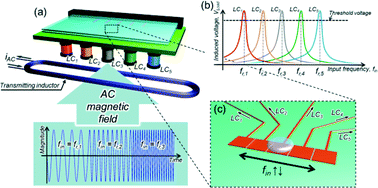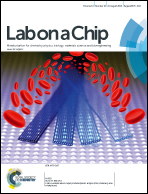Wireless EWOD/DEP chips powered and controlled through LC circuits and frequency modulation
Abstract
This paper presents novel wireless EWOD/DEP chips that are wirelessly powered and controlled through LC circuits with one-to-many transmitter–receiver coupling. Each receiving LC circuit connected to the EWOD/DEP electrode is designed to have a different resonant frequency. When the input frequency is close to one of the resonant frequencies of receiving LC circuits, the induced voltage on the corresponding EWOD/DEP electrode will increase due to the resonance. Therefore, electrodes can be selectively and sequentially activated to provide sufficient EWOD or DEP force to manipulate the droplet or liquid by modulating the input frequency. Unlike previously reported wireless EWOD or DEP devices powered through one-to-one transmitter–receiver coupling, the transmitting inductor in the one-to-many transmitter–receiver coupling design proposed here is much larger than the total sizes of receiving inductors. Therefore, receiving inductors can be easily covered and coupled by the transmitting inductor. Here, droplet transport, splitting, and merging are successfully demonstrated using 5 receiving LC circuits at different input frequencies (1210–1920 Hz). Liquid pumping with multiple electrodes by wireless DEP is also demonstrated using 5 receiving LC circuits at higher input frequencies (51.2–76.1 kHz). Furthermore, liquid pumping with a continuous meandered electrode by wireless DEP is demonstrated through the resonant frequency shifting effect. It shows that the liquid pumping distance on a continuous electrode also can be tuned by proper frequency modulation.


 Please wait while we load your content...
Please wait while we load your content...